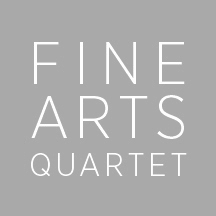CRESCENDO MAGAZINE Le 19 janvier 2020 par Yvan Beuvard
https://www.crescendo-magazine.be/leternelle-jeunesse-du-fine-arts-quartet/
L’éternelle jeunesse du Fine Arts Quartet
Les jeunes quatuors en quête de notoriété abordent Beethoven avec les Razumovsky, Bartok et Chostakovitch avec leurs derniers chefs-d’oeuvre. A l’inverse, le Fine Arts Quartet, l’un des très grands du 20e siècle encore en activité, nous propose ce soir trois œuvres de jeunesse, que l’on entend rarement au concert. Une grande tournée internationale l’a conduit à Dijon, où il n’était pas réapparu depuis 2011 (fabuleux concert avec Menahem Pressler). Comment, du reste, ne pas faire le parallèle entre le regretté Beaux Arts Trio de ce dernier et notre quatuor ? La ressemblance ne s’arrête pas aux titres. Les deux formations ont en partage la longévité -nées aux Etats-Unis après la seconde guerre mondiale- l’abondance des concerts et des enregistrements, le répertoire illustré, et, surtout, l’appartenance au panthéon des interprètes... La perfection souveraine du Fine Arts Quartet, tout en ne sacrifiant jamais l’énergie juvénile, la fraîcheur, gomme les aspects un peu frustes, lourdauds du jeune Beethoven pour une élégance aristocratique...La traduction qu’en donnent les musiciens du quatuor est d’une qualité exceptionnelle, avec un art de ménager les attentes, de suspendre le discours pour renouveler les expressions et structurer l’architecture. Pour avoir écouté en leur temps les plus illustres des quatuors « historiques » (Hongrois, Talich, Vegh, Juilliard, Budapest, Alban Berg etc.), on pourrait être blasé, encombré de références. Or on quitte la salle transporté dans ce monde idéal, où la fusion des instrumentistes fait oublier leur individualité, avec toutes les qualités imaginables de précision, de phrasé, de couleur, conférant la vie à chaque note, à chaque rythme. La maturité qui a conservé la jeunesse, la perfection. Deux généreux et amples bis, Rachmaninov, puis le finale de la Grande fugue, op. 133 de Beethoven, vont combler le très nombreux public, enthousiaste comme rarement. Une soirée qui restera gravée dans les mémoires.
Dijon, Auditorium, le 16 janvier 2020
The Eternal Youth of the Fine Arts Quartet
"Young quartets in search for notoriety approach Beethoven with the Razumovsky, Bartok and Chostakovitch with their latest masterpieces. Conversely, the Fine Arts Quartet, one of the very greatest quartets of the 20th century still active, offers us three works of youth this evening, which are rarely heard at concerts. A major international tour took the Quartet to Dijon, where they haven't appeared since their fabulous concert in 2011 with Menahem Pressler. How, then, is it possible not to draw a parallel between the Beaux Arts Trio in its later years and our Quartet? The resemblance doesn't stop at titles. The two groups share their longevity - born in the United States after the Second World War - the abundance of concerts and recordings, the illustrious repertoire, and, above all, belonging to the pantheon of interpreters... The sovereign perfection of the Fine Arts Quartet's playing never sacrificed youthful energy, freshness, while interpreting the somewhat crude, clumsy aspects of the young Beethoven with an aristocratic elegance ... The rendition that the musicians of the quartet give is of exceptional quality, with an art of sparing expectations, of suspending speech to renew expressions and structural architecture. For having listened to the most illustrious of the "historical" quartets (Hungarian, Talich, Vegh, Juilliard, Budapest, Alban Berg etc.) in their time, one could be jaded, cluttered with references. But we leave the room transported to this ideal world, where the fusion of instrumentalists makes us forget their individuality, with all imaginable qualities of precision, phrasing, color, giving life to each note, at each rhythm. The maturity which has preserved youth, perfection. Two generous and ample encores, Rachmaninoff, then the finale of the Great Fugue, Op. 133 by Beethoven, will gratify the very large audience, rarely before so enthusiastic. An evening that will remain etched in our memories."
(Yvan Beuvard, CRESCENDO MAGAZINE, January 19, 2020)
